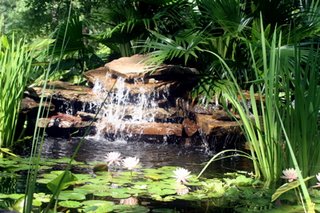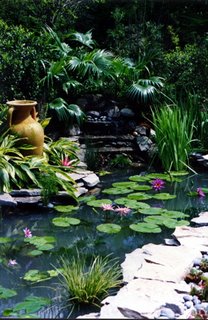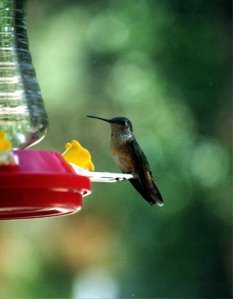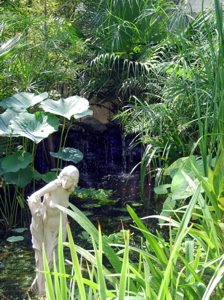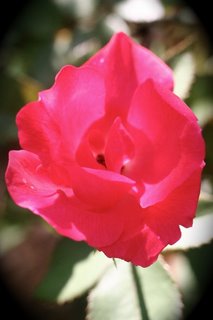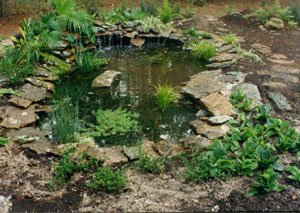
Tropical Water Lilies
by Rich Sacher, Owner, American Aquatic Gardens, New Orleans, La
(Zone 9 Directions)
Tropical water lilies are very easy to grow and their blooming season in New Orleans is from May 1st until a killing frost in December. They come in a wide variety of colors, including some varieties which bloom at night. A well-grown plant will have several flowers open every day of its eight month blooming season, and each flower lasts three days.
•Sunlight
Water lilies must have a minimum of five hours of direct sunlight in order to bloom heavily; the more sun, the better.
•Water
Water lilies requre a minimum of six inches of water over the soil level in the pot; larger lilies can take 8 to 10 inches depth of water. Water does not have to be circulated and quiet fountains will not harm the waterlilies.
•Soil
Any heavy garden soil is suitable, but no peat moss, bark or other floating materials should be used.
•Fish
If you have fish in your pond, cover the soil of your waterlily pot with heavy pieces of broken slate, sand or pea gravel so fish cannot dig up the plants.
•Algae
Green water is often a problem in full sun and well fertilized plants; do not use chemicals to control the algae--it will kill your lilies. Instead, encourage a healthy growth of submerged plants like anacharis one bunch per square foot of surface area, which will help starve out the algae. Some floating hyacinths or water lettuce will also help, but watch they do not get out of control.
•Chores
To keep the pond looking good, remove yellowing leaves and spent flowers every week. If an individual lily spreads too much, you can remove the outer ring of leaves to reduce the overall size of the plant without affecting flowering. If aphids appear, hose them into the water each morning to provide food for your fish. Caterpillars can be picked off by hand.
•Treating for Aphid Infestation
The following technique can be used to treat water lilies for aphid infestation without harm to your fish. Aphids and many other garden pests can be easily controlled with an inexpensive, homemade insecticide--according to the U.S. Department of Agriculture.
This recipe was developed after entomologists at the Agriculture Research Center in Phoenix, Arizona, discovered that a spray of soybean oil protected cotton from aphids and whiteflies. Home gardeners should mix one tablespoon of dishwashing detergent with one cup of cooking oil. When pests strike, mix one to two and one half teaspoons of the detergent oil mix with one cup of water. The detergent causes the oil to emulsify in the water. It can be sprayed on the water lilies every ten days. Besides aphids, the mixture works against whiteflies and spider mites. It has been successfully tested on eggplants, carrots, lettuce, celery, watermelon, peppers and cucumbers. It tends to burn the leaves of squash, cauliflower and red cabbage.
•Over-wintering Tropical Water Lilies
Tropical water lilies are perennial by nature, and they will go dormant as the weather becomes cold and days grow shorter. In New Orleans, they will often bloom until mid to late December, at which time the plants are already becoming smaller and slow growing.
You should stop fertilizing the lilies is mid October, because by starving the plants at the end of the season, they are more likely to form some small, very hard and durable tubers which survive the dormant period much better than the large fleshy root of the main plant.
These small tubers can be broken off from the parent plant and rinsed clean of soil; they should be stored in damp sand for the winter at a temperature of 50 to 55 degrees. These tubers can be planted out in the pond in mid-April, when they will begin to sprout new leaves by the middle of May. (Plant them in rich or fertilized soil, one half inch below the soil surface, and place them in a shallow area of the pond with 2 to 4 inches of water over the pot.)
If you have a greenhouse, you should move your waterlily to a small tub or temporary pond inside. In this case, do not disturb the roots; allow the plant to continue growing until it becomes dormant and leave it in the pond until new leaves come up again the spring. Once the plant is growing again, it can be divided if necessary and repotted in fresh solid for the growing season. This method almost always ensures the survival of the plant if the temperature never goes below 55 degrees in your greenhouse.
Those persons who are fortunate enough to have a large natural pond will find that just leaving the lily in the pond through the winter is the best method; this is especially true if the pond is fed by artesian wells, where the water temperature stays above 50 degrees no matter how cold the winter nights might be. This allows the plant to go dormant, but the temperature is warm enough to prevent damage to the tubers.
If the water temperature of your pond goes below 45 degrees for a number of days during the winter, then you will need to move the plant or tubers indoors for the dormant season, because temperatures below 50 degrees may result in the death of the tubers.
Since winters in New Orleans are so unpredictable, I would guess that most people would have about a 50 percent success rate if they just let their lilies in their ponds through the winter. The determining factor is temperature; how cold does it get and how long does it stay cold.
So if you enjoy a challenge, try one of these methods of over-wintering your lilies. Or, if you want to be more laid back about it, you can do nothing at all and take a chance on Mother Nature. You should win about half the time.
